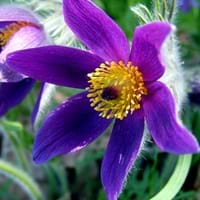Life Span
Perennial
Annual and Perennial
Origin
North America, United States, Northeastern United States, Mid-Atlantic United States, Southeastern United States, North-Central United States, South-Central United States, Texas
Europe, Eastern Europe, Southern Europe, Western Europe, United Kingdom
Types
not available
Pulsatilla vulgaris, Pulsatilla vulgaris rubra, Pulsatilla vulgaris alba
Number of Varieties
Not Available
Habitat
Boggy areas, Fens, Fields, meadows, Swamps, Woodlands
meadows, Slopes, Wooded slopes
USDA Hardiness Zone
4-9
5-7
Sunset Zone
1a, 1b, 2a, 2b, 3a, 3b, 4, 5, 6, 7
2b, 3a, 3b, 4, 5, 6, 15, 16, 17
Habit
Thicket/Colonizing
Clump-Forming
Flower Color
Not Available
Indigo, Purple, Violet
Flower Color Modifier
Not Available
Not Available
Fruit Color
Red
Greyish Brown
Leaf Color in Spring
Not Available
Light Green
Leaf Color in Summer
Not Available
Light Green
Leaf Color in Fall
Not Available
Light Green
Leaf Color in Winter
Not Available
Light Green
Leaf Shape
Oblovate
Rosette
Plant Season
Spring, Fall, Winter
Spring
Sunlight
Full Sun, Partial Sun
Full Sun
Type of Soil
Clay, Loam
Loam, Sand
The pH of Soil
Acidic, Neutral, Alkaline
Neutral, Alkaline
Soil Drainage
Average
Well drained
Bloom Time
Late Spring
Early Spring, Spring
Tolerances
Not Available
Drought
Where to Plant?
Ground, Pot
Ground, Pot
How to Plant?
Divison, Seedlings
root cutting, Seedlings
Plant Maintenance
Medium
Medium
Watering Requirements
Keep the ground moist but not water-logged
Medium
In Summer
Lots of watering
Lots of watering
In Spring
Moderate
Moderate
In Winter
Average Water
Average Water
Soil pH
Acidic, Neutral, Alkaline
Neutral, Alkaline
Soil Type
Clay, Loam
Loam, Sand
Soil Drainage Capacity
Average
Well drained
Sun Exposure
Full Sun, Partial Sun
Full Sun
Pruning
Prune after flowering, Prune in early spring, Remove damaged leaves, Remove dead branches, Remove dead leaves
Remove damaged leaves, Remove dead branches, Remove dead leaves
Fertilizers
All-Purpose Liquid Fertilizer, Compost, Fertilize every year, Mulch, Nitrogen
All-Purpose Liquid Fertilizer
Pests and Diseases
Aphids, Apple Maggot, Fall Webworm, Red blotch, Scale
Cutworms, Larvae of Agave Weevil
Plant Tolerance
Not Available
Drought
Flower Petal Number
Not Available
Single
Foliage Texture
Not Available
Fine
Foliage Sheen
Not Available
Matte
Attracts
Birds
Not Available
Allergy
Not Available
convulsions, Diarrhea, Not Available, Stomach pain, Vomiting
Aesthetic Uses
Showy Purposes
along a porch, deck or patio, Showy Purposes
Beauty Benefits
Not Available
Not Available
Environmental Uses
Air purification
Air purification
Medicinal Uses
Not Available
Not Available
Part of Plant Used
Fruits
Not Available
Other Uses
Used As Food, Used as Ornamental plant
Showy Purposes
Used As Indoor Plant
No
No
Used As Outdoor Plant
Yes
Yes
Garden Design
Cutflower, Mixed Border, Screening, Wind Break
Alpine, Mixed Border, Rock Garden / Wall
Botanical Name
ARONIA arbutifolia
PULSATILLA vulgaris
Common Name
Red Chokeberry
Pasque Flower, wind flower, prairie crocus, Easter Flower, meadow anemone
In Hindi
लाल Chokeberry
Pasque Flower
In German
Rote Apfelbeere
Kuhschellen
In French
Red Chokeberry
Pasque Flower
In Spanish
rojo Chokeberry
Pasque Flower
In Greek
κόκκινο Chokeberry
Pasque Flower
In Portuguese
Red Chokeberry
Pasque Flower
In Polish
Red aronii
Sasanka
In Latin
arbutifolia
Pasque Flower
Phylum
Magnoliophyta
Vascular plant
Class
Magnoliopsida
Magnoliopsida
Order
Rosales
Ranunculales
Family
Rosaceae
Ranunculaceae
Clade
Angiosperms, Eudicots, Rosids
Angiosperms, Eudicots
Subfamily
Not Available
Not Available
Number of Species
Not Available
Season and Care of Red Chokeberry and Pasque Flower
Season and care of Red Chokeberry and Pasque Flower is important to know. While considering everything about Red Chokeberry and Pasque Flower Care, growing season is an essential factor. Red Chokeberry season is Spring, Fall and Winter and Pasque Flower season is Spring, Fall and Winter. The type of soil for Red Chokeberry is Clay, Loam and for Pasque Flower is Loam, Sand while the PH of soil for Red Chokeberry is Acidic, Neutral, Alkaline and for Pasque Flower is Neutral, Alkaline.
Red Chokeberry and Pasque Flower Physical Information
Red Chokeberry and Pasque Flower physical information is very important for comparison. Red Chokeberry height is 180.00 cm and width 12.70 cm whereas Pasque Flower height is 12.70 cm and width 15.20 cm. The color specification of Red Chokeberry and Pasque Flower are as follows:
Red Chokeberry flower color: Not Available
Red Chokeberry leaf color: Not Available
Pasque Flower flower color: Indigo, Purple and Violet
- Pasque Flower leaf color: Light Green
Care of Red Chokeberry and Pasque Flower
Care of Red Chokeberry and Pasque Flower include pruning, fertilizers, watering etc. Red Chokeberry pruning is done Prune after flowering, Prune in early spring, Remove damaged leaves, Remove dead branches and Remove dead leaves and Pasque Flower pruning is done Remove damaged leaves, Remove dead branches and Remove dead leaves. In summer Red Chokeberry needs Lots of watering and in winter, it needs Average Water. Whereas, in summer Pasque Flower needs Lots of watering and in winter, it needs Average Water.





